Margo Kelly's Blog, page 23
August 19, 2016
UNLOCKED = "A Breath of Fresh Air"
I came across this terrific picture and wonderful review of UNLOCKED by @MyBookCushion on Instagram. To read the full, 5-star review, visit My Book Cushion.
Finishing up with some ARCs this month. I think I still got 3 more books to go! But fortunately, I have been enjoying all the books so far. . Unlocked by Margo Kelly is about a teenage girl who is losing a grip on reality, ever since she participated in a carnival hypnosis act. She started to see and hear things nobody else seems to notice and causes her to lose control of the car she is driving, taking away the life of her best friend's boyfriend. But is what she is seeing real? or is she a victim of evil spirits or is she being manipulated by someone? . I don't usually read thrillers and suspense when it comes to YA reads, but this book is a breath of fresh air. I really love how the story unfolds and how Hannah fought to bring her life back to normal. The link to my review is on my bio, please check it out. . Are you reading an ARC right now? What are you reading today? ^_^A photo posted by Bheiy Agbayani (@mybookcushion) on Aug 9, 2016 at 6:21am PDT
Published on August 19, 2016 10:18
August 18, 2016
Book Review + Giveaway: SCAVENGER OF SOULS by Joshua David Bellin
Today's a great day to be a reader, and I'm happy to be participating in a blog tour to celebrate the new book, SCAVENGER OF SOULS! My full review is at the bottom of this post, AND there's a giveaway - so be sure to scroll down for everything!
 Publisher: Margaret K. McElderry Books
Publisher: Margaret K. McElderry Books
Age: 12+
Release date: August 23, 2016
For order links, visit http://joshuadavidbellin.com/my-books/
Available in hardcover and e-book
Description:
Querry Genn is running out of time. He may have saved his survival colony and defeated a nest of the monstrous Skaldi, but that doesn’t mean he has any more answers to who he is. And Querry’s mother, Aleka, isn’t talking. Instead, she’s leading the colony through a wasteland of unfamiliar territory. When they reach Aleka’s destination, everything Querry believed about his past is challenged.
In the middle of a burned-out desert, an entire compound of humans has survived with plenty of food and equipment. But the colonists find no welcome there, especially from Mercy, the granddaughter of the compound’s leader. Mercy is as tough a fighter as Querry has ever seen—and a girl as impetuous as he is careful. But the more Querry learns about Mercy and her colony, the more he uncovers the gruesome secrets that haunt Mercy’s past—and his own.
With threats mounting from the Skaldi and the other humans, Querry must grapple with the past and fight to save the future. In the thrilling conclusion to the story that began with Survival Colony 9, Joshua David Bellin narrates a tale of sacrifice, courage against overwhelming odds, and the fateful choices that define us for a lifetime.
Praise for Survival Colony 9:
Tantalizing mysteries abound among the human and inhuman inhabitants of the bleak landscape, and the post-apocalyptic plot is satisfyingly full of twists.—Booklist
Joshua David Bellin brings serious game in a post-apocalyptic thriller that collides breathless action with devious world building and genuine heart. A terrific novel!—Jonathan Maberry, New York Times bestselling author of Rot & Ruin and V-Wars
Set in a gritty post-apocalyptic world, Survival Colony 9 is both an adventure and an exploration of what it means to be human.—Margaret Peterson Haddix, New York Times bestselling author of the Missing Series
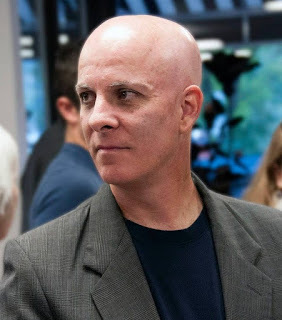 About the author:
About the author:
Joshua David Bellin has been writing novels since he was eight years old (though the first few were admittedly very short). He taught college for twenty years, wrote a bunch of books for college students, then decided to return to fiction. Survival Colony 9 is his first novel, with the sequel, Scavenger of Souls, set to release on August 23, 2016. A third YA science fiction novel, the deep-space adventure/romance Freefall, will appear in 2017.
Josh loves to read, watch movies, and spend time in Nature with his kids. Oh, yeah, and he likes monsters. Really scary monsters.
To find out more about Josh and his books, visit him at the following:
Website: http://www.joshuadavidbellin.com
Blog: http://theyaguy.blogspot.com/
Twitter: http://twitter.com/TheYAGuy
Facebook: http://www.facebook.com/joshuadavidbellin
Goodreads: https://www.goodreads.com/author/show/7393959.Joshua_David_Bellin
My Review of SCAVENGER OF SOULS:
If you have read Survival Colony 9, you must read Scavenger of Souls! And if you have not read Survival Colony 9 – what are you waiting for? Both books are fantastic, and Scavenger of Souls did not disappoint as a sequel. It picked up the storyline with Querry Genn and his quest to learn more about his past, but the journey is far from an easy one.
Joshua Bellin has an amazing talent for building worlds, developing characters, and devising an intricate plotline.
Bellin created a desolate setting, which Querry must traverse to save himself and his friends while fighting the Skaldi. In Scavenger of Souls, there were some new plot elements, some new characters, and some old issues resolved. As Querry learns more and more about himself and about the world he lives in, he realizes “Answers aren’t always true … and the truth isn’t always the answer you want” (page 8).
Some of my favorite lines from the book:
“It felt like the nervous energy that comes from staying up too many nights in a row, that feeling of hypersensitivity all along your scalp and pressure building behind your eyeballs.”
“The sky had turned the color of a day-old bruise, reducing the glow of the black desert to a dull gleam like burnished metal.”
I recommend both Survival Colony 9 and Scavenger of Souls. Plus, the great news is - if you’ve not already read the first book, you can read it now and go immediately into the second book with no wait in between! YAY for books. And YAY for Joshua Bellin and his terrific novels.
Be sure to enter the giveaway:
a Rafflecopter giveaway
Happy reading!

 Publisher: Margaret K. McElderry Books
Publisher: Margaret K. McElderry BooksAge: 12+
Release date: August 23, 2016
For order links, visit http://joshuadavidbellin.com/my-books/
Available in hardcover and e-book
Description:
Querry Genn is running out of time. He may have saved his survival colony and defeated a nest of the monstrous Skaldi, but that doesn’t mean he has any more answers to who he is. And Querry’s mother, Aleka, isn’t talking. Instead, she’s leading the colony through a wasteland of unfamiliar territory. When they reach Aleka’s destination, everything Querry believed about his past is challenged.
In the middle of a burned-out desert, an entire compound of humans has survived with plenty of food and equipment. But the colonists find no welcome there, especially from Mercy, the granddaughter of the compound’s leader. Mercy is as tough a fighter as Querry has ever seen—and a girl as impetuous as he is careful. But the more Querry learns about Mercy and her colony, the more he uncovers the gruesome secrets that haunt Mercy’s past—and his own.
With threats mounting from the Skaldi and the other humans, Querry must grapple with the past and fight to save the future. In the thrilling conclusion to the story that began with Survival Colony 9, Joshua David Bellin narrates a tale of sacrifice, courage against overwhelming odds, and the fateful choices that define us for a lifetime.
Praise for Survival Colony 9:
Tantalizing mysteries abound among the human and inhuman inhabitants of the bleak landscape, and the post-apocalyptic plot is satisfyingly full of twists.—Booklist
Joshua David Bellin brings serious game in a post-apocalyptic thriller that collides breathless action with devious world building and genuine heart. A terrific novel!—Jonathan Maberry, New York Times bestselling author of Rot & Ruin and V-Wars
Set in a gritty post-apocalyptic world, Survival Colony 9 is both an adventure and an exploration of what it means to be human.—Margaret Peterson Haddix, New York Times bestselling author of the Missing Series
 About the author:
About the author:Joshua David Bellin has been writing novels since he was eight years old (though the first few were admittedly very short). He taught college for twenty years, wrote a bunch of books for college students, then decided to return to fiction. Survival Colony 9 is his first novel, with the sequel, Scavenger of Souls, set to release on August 23, 2016. A third YA science fiction novel, the deep-space adventure/romance Freefall, will appear in 2017.
Josh loves to read, watch movies, and spend time in Nature with his kids. Oh, yeah, and he likes monsters. Really scary monsters.
To find out more about Josh and his books, visit him at the following:
Website: http://www.joshuadavidbellin.com
Blog: http://theyaguy.blogspot.com/
Twitter: http://twitter.com/TheYAGuy
Facebook: http://www.facebook.com/joshuadavidbellin
Goodreads: https://www.goodreads.com/author/show/7393959.Joshua_David_Bellin
My Review of SCAVENGER OF SOULS:
If you have read Survival Colony 9, you must read Scavenger of Souls! And if you have not read Survival Colony 9 – what are you waiting for? Both books are fantastic, and Scavenger of Souls did not disappoint as a sequel. It picked up the storyline with Querry Genn and his quest to learn more about his past, but the journey is far from an easy one.
Joshua Bellin has an amazing talent for building worlds, developing characters, and devising an intricate plotline.
Bellin created a desolate setting, which Querry must traverse to save himself and his friends while fighting the Skaldi. In Scavenger of Souls, there were some new plot elements, some new characters, and some old issues resolved. As Querry learns more and more about himself and about the world he lives in, he realizes “Answers aren’t always true … and the truth isn’t always the answer you want” (page 8).
Some of my favorite lines from the book:
“It felt like the nervous energy that comes from staying up too many nights in a row, that feeling of hypersensitivity all along your scalp and pressure building behind your eyeballs.”
“The sky had turned the color of a day-old bruise, reducing the glow of the black desert to a dull gleam like burnished metal.”
I recommend both Survival Colony 9 and Scavenger of Souls. Plus, the great news is - if you’ve not already read the first book, you can read it now and go immediately into the second book with no wait in between! YAY for books. And YAY for Joshua Bellin and his terrific novels.
Be sure to enter the giveaway:
a Rafflecopter giveaway
Happy reading!

Published on August 18, 2016 01:30
August 11, 2016
Turkish Rights for UNLOCKED Sold to Pegasus
Ben Türkiye'de bir yayıncıya benim müthiş ajan ve ekibi UNLOCKED, Türk haklarını sattı duyurmaktan mutluyum! Bu benim ilk yabancı hakları anlaşma ve ben çok heyecanlıyım.
...
Oh. Just in case you don't read Turkish, let me translate for you:
"I am thrilled to announce that my awesome agent and her team have sold the Turkish rights to UNLOCKED to a publisher in Turkey! This is my first foreign rights deal, and I am so excited."
...
Furthermore, the Turkish publisher, Pegasus, has translated books for great authors like John Green, Brandon Mull, and Aprilynne Pike. I’m excited to be among such great company.
Happy reading!
...
Oh. Just in case you don't read Turkish, let me translate for you:
"I am thrilled to announce that my awesome agent and her team have sold the Turkish rights to UNLOCKED to a publisher in Turkey! This is my first foreign rights deal, and I am so excited."
...
Furthermore, the Turkish publisher, Pegasus, has translated books for great authors like John Green, Brandon Mull, and Aprilynne Pike. I’m excited to be among such great company.
Happy reading!
Published on August 11, 2016 09:45
August 8, 2016
Not Really a Necromancer
One of my favorite lines in UNLOCKED comes after Plug introduces Hannah to his dad, Necro. He's a tattoo artist, and most of his designs feature death in some regard. So ... his friends call him Necro, short for necrophilia or necromancer. But he's not really a necromancer. ;)
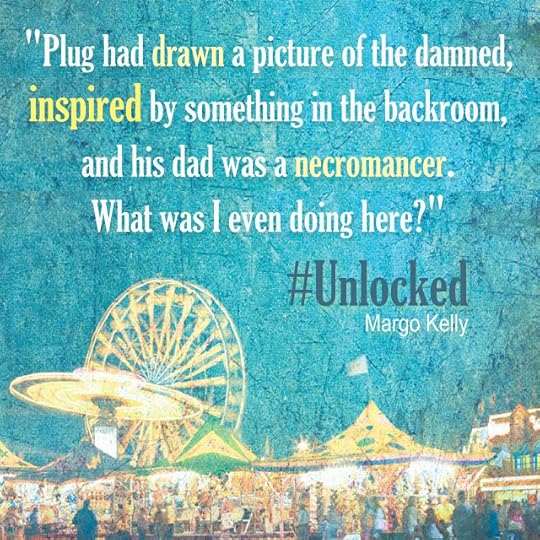

Published on August 08, 2016 05:47
August 5, 2016
Book Review: RAISING HUMAN BEINGS by Ross W. Greene
 Raising Human Beings: Creating a Collaborative Partnership with Your Child by Ross W. Greene
Raising Human Beings: Creating a Collaborative Partnership with Your Child by Ross W. GreeneMy rating: 4 of 5 stars
I highly recommend this book. It would make a great gift for parents with children of any age – but the younger the better. It’s easier to instill a sound pattern of parenting when the kids are young; although, this book does offer excellent examples of changing parental styles even when the kids are teenagers.
Over the years, I’ve read quite a few parenting books, and one of the things I’ve learned is: you do not have to agree with every single bit of advice offered within the pages. Take what works for you and apply it to your situation.
Ross W. Greene, PhD, has taken experiences from his twenty-five years of being a clinical psychologist and organized his advice in a very easy-to-read format. Instead of compiling pages and pages of never-ending advice and examples all in the same font and line spacing, the author (and editor and publisher, I assume) diversified the text. There are paragraphs where straight information is delivered, there are case studies presented in stories, there are Q&A sections, and there are plenty of subtitles to help keep you engaged with the book. While most of the writing is excellent, Greene does like to start sentences with the word “but” and he loves his creative dialogue tags such as hissed, mumbled, grumbled, and protested. None of which actually took away from the overall content, but it was distracting to me.
While I loved and agreed with much of Greene’s advice, I will tell you that I let my babies cry themselves to sleep in their cribs. After reading this book, if I had to do all over again, I would still let my babies cry themselves to sleep. And yet, I am certainly one to advocate parents considering alternatives to figure out what works best for them.
Greene’s straight-forward method of “Creating a Collaborative Partnership with Your Child” is one that will foster kinder human beings who are able to problem solve with empathy not only while growing up but also as adults.
Some of my favorite ideas and lines from the book:
“Identity achievement refers to a person who has both undergone the identity exploration process and has also developed a well-defined self-concept and identity. She know who she is, what she believes, and where she’s going” (page 24).
“What’s best for him is likely to involve more ‘listening’ than ‘lessoning’” (page 35).
“Your child would prefer to be doing well” (page 39).
“But there’s another reason solving problems collaboratively is hard: many adults haven’t had much practice at it, having been raised by parents who were probably highly skilled at demanding and insisting” (page 81).
“I’ve worked with three-year-olds who had an easier time participating verbally than some seventeen-year-olds” (page 190).
“We live in the information age, and we are saturated with demands for empathy … sadly, that fatigue sometimes causes us to respond with less compassion and empathy in our interactions with our children…” (page 240).
View all my reviews
Published on August 05, 2016 18:07
August 4, 2016
Camping in Idaho
One of my favorite things is camping. My husband and I have certain spots that are our favorites, but this time, we decided to explore a bit. We had a wonderful time. Here are a few pictures (okay, a LOT of pictures) from our trip:
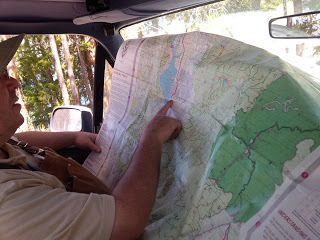
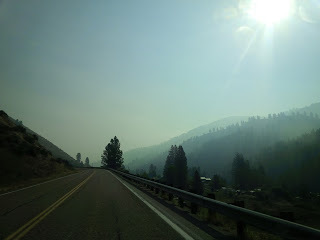
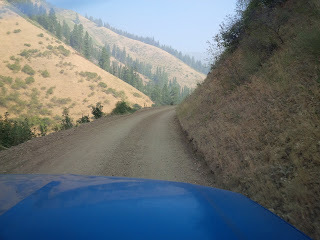









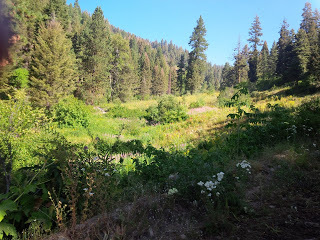



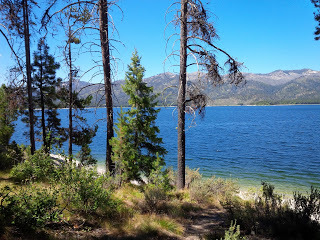
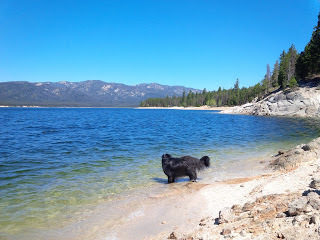

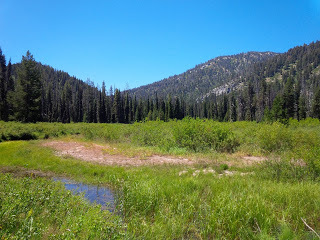






















Published on August 04, 2016 20:55
Book Review & Commentary - THE NEW TRAIL OF TEARS by Naomi Schaefer Riley
When I was offered a chance to read this book, I jumped at the opportunity. Scroll down for my review of the book AND for an intriguing commentary on the topic.
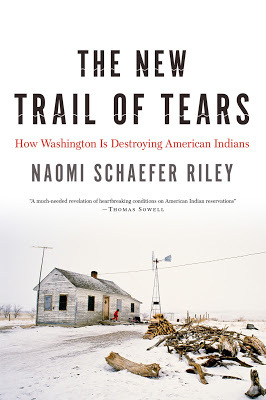 The New Trail of TearsHow Washington Is Destroying American IndiansBy Naomi Schaefer RileyPublished by Encounter BooksHardcover; 184 pages; $23.99July 26, 2016; 9781594038532
The New Trail of TearsHow Washington Is Destroying American IndiansBy Naomi Schaefer RileyPublished by Encounter BooksHardcover; 184 pages; $23.99July 26, 2016; 9781594038532
Publisher's Description If you want to know why American Indians have the highest rates of poverty of any racial group, why suicide is the leading cause of death among Indian men, why native women are two and a half times more likely to be raped than the national average and why gang violence affects American Indian youth more than any other group, do not look to history. There is no doubt that white settlers devastated Indian communities in the 19th, and early 20th centuries. But it is our policies today–denying Indians ownership of their land, refusing them access to the free market and failing to provide the police and legal protections due to them as American citizens -- that have turned reservations into small third-world countries in the middle of the richest and freest nation on earth.
The tragedy of our Indian policies demands reexamination immediately -- not only because they make the lives of millions of American citizens harder and more dangerous -- but also because they represent a microcosm of everything that has gone wrong with modern liberalism. They are the result of decades of politicians and bureaucrats showering a victimized people with money and cultural sensitivity instead of what they truly need -- the education, the legal protections and the autonomy to improve their own situation.
If we are really ready to have a conversation about American Indians, it is time to stop bickering about the names of football teams and institute real reforms that will bring to an end this ongoing national shame.

Author Bio Naomi Schaefer Riley, author of The New Trail of Tears, is a weekly columnist for the New York Post and a former Wall Street Journal editor and writer whose work focuses on higher education, religion, philanthropy and culture. She is the author of several books on those topics. Her book, ‘Til Faith Do Us Part: How Interfaith Marriage is Transforming America (Oxford, 2013), was named an editor’s pick by the New York Times Book Review. Ms. Riley’s writings have appeared in the Wall Street Journal, the New York Times, the Boston Globe, the LA Times, and the Washington Post, among other publications. She appears regularly on FoxNews and FoxBusiness. She has also appeared on Q&A with Brian Lamb as well as the Today Show. She graduated magna cum laude from Harvard University in English and Government. She lives in the suburbs of New York with her husband, Jason, and their three children.
My Review I am not Native American, but I am interested in all cultures and I jumped at the opportunity to read this book by Naomi Schaefer Riley. She stated in the acknowledgments, “When people ask me how I came to write a book about American Indians, I can only say anger. For years, I had read about the poverty, suicide, abuse, and alcohol and drug problems on reservations with deep sense of sadness” (page 187).
THE NEW TRAIL OF TEARS is a well-written book addressing current concerns of Native Americans. Riley included so many facts in the narrative that I often had to set the book down, because I felt like I was taking an accelerated sociology class. Riley cited her research throughout and included an extensive list of references at the back of the book. I did not take the time to verify any of the information.
Some interesting details mentioned by Riley caught my attention: --- “There are 562 federally recognized Indian nations in the United States – about half of which are in Alaska – and 310 reservations” (page xii).--- “Violent crime on the country’s 310 reservations is on average about 2.5 times as high as the national average” (page 7).--- “American Indians, it turns out, have served in the military at the highest rate of any group since the American Revolution. According to the Defense Department, as of 2012 there were more than 22,000 American Indians and Alaska Natives on active duty, and the 2010 census identified over 150,000 American Indian and Alaska Native veterans. Twenty-seven have been awarded the Medal of Honor” (page 175).--- “It was not until after World War II in the 1965 passage of the Voting Rights Act that all states were required to allow Native Americans to vote on the same basis as any other American” (page 175).
A great portion of the book addressed the issue of property ownership. I had zero knowledge of this beforehand. I found it quite mind boggling how complicated the federal government has made it for Native Americans to own land, and the problem still exists today. That’s ridiculous. Furthermore, it’s not just in the USA but also in Canada. “In Canada, there are three types of individuals not allowed to own property – kids, the mentally incompetent, and Indians living on reserves” (page 44). The issues are too complicated for me to highlight in my review. Read the book.
“Underlying federal policy are the assumptions that Indians are simply incapable of managing their own affairs and that natural resource development somehow runs contrary to their traditions” (page 13).
Tribal economics represented another relevant issue addressed in Riley’s book. “The unemployment rate for the 8,000 tribe members [of the Northern Cheyenne] who live on the reservation is more than 80 percent … the most talented people on the reservation tend to leave” (pages 20-21).
So the federal government has offered Native Americans “what you might call a loophole economy. We allow Indians to engage in enterprises that we can’t or won’t have in other neighborhoods. It used to be selling tax-free cigarettes, liquor, and gasoline. Then it was the gaming industry. Now, more states are allowing casinos to be run by non-Indians, and casinos aren’t the source of profit they once were. But never fear. The Justice Department decided in December 2014 to allow marijuana to be grown on reservations – even if the drug is illegal in the state where the reservation is located. Gambling, cigarettes, alcohol, drugs – who wouldn’t want these businesses to form the economic backbone of their community?” (page 50).
I could go on and on referencing the disappointing details presented in this book, which only reflect the current state of affairs for Native Americans, but I’ll let you read the book. I was surprised at my lack of awareness, which I attribute to my own privilege and naivety. So whether you think we should continue to celebrate Columbus Day (touted as celebrating the explorer who launched a genocide) or replace it with “Indigenous Peoples’ Day” take the time to look at this book. It is a very worthwhile read, especially for anyone interested in equal rights for all, sociology, or psychology.
I am passing my copy of the book along to one of my Native American friends, and I look forward to being able to discuss it with her and read her review of the book.
Furthermore, please, continue reading for an intriguing opinion piece written by a Cherokee descendant.
[I received a copy of this book for free in exchange for an honest review. This in no way influenced my opinion of the book.]
Ramshackle Trailers - An Opinion Piece by Artemis Grey My Grandfather’s side of the family doesn’t really exist. You see, my grandfather was Cherokee. He wasn’t a Cherokee prince, and his mother wasn’t a princess, and her father wasn’t a king or chief. They were just people. People who had to choose between walking thousands of miles and probably dying for who they were, or pretending to be white people. My great grandmother grew up learning how to be white. The only time her hair was ever braided was when she was dying of cancer, and even then, she worried she would “look like a savage”. My grandfather probably didn’t even think of it as “acting” like a white person. I’ll never know for sure. By the time I was old enough to ask questions like that, he was dead.
A hundred years after American Indians were systematically forced to pretend to be white, the tables have turned. Now, it’s fashionable to be an Indian. Everyone seems have a “Cherokee princess” for a grandmother. Millions of dollars in profit are made yearly by white designers, white artists, white pretty much everyone, off Native inspired items. I’m saying this as a white person. I can’t be anything but white because I was never raised any way but the white way. I know what my grandfather, great grandmother, and great great grandfather were, but I don’t know whothey were, and I never will. The chance for that is gone.
So too, is the chance slipping away for the entirety of white America–along with other races–to ever know whothe remaining indigenous peoples are. Whatever Americans picture when someone says the words “American Indian” or “Native American” it usually involves teepees, war parties, buffalo hunts, leather and fringe and fancy headdresses. No one pictures ramshackle trailers with caved-in roofs, sheltering a dozen family members. No one pictures a suicide rate triple the national average. No one pictures wastelands of civilization where people are told to do for themselves but deprived of the means by which to act, told to make something of themselves, but denied the chance to be educated, told to govern themselves, but smothered by federal regulations. No one ever pictures Wallstreet stockbrokers, millionaire recording artists, Hollywood socialites, or Greenwich Village mansion owners, either.
From the moment white Europeans set foot on this continent, the indigenous peoples of America have been exploited and idealized, in equal parts. The image non-Indians have of Indian is one established and maintained by their white contemporaries. The majority of books written about Native Americans have been written by white men (mostly) and white women. Some of these books and articles idealize Indians, and some of them vilify them. Some call for the government to provide them more opportunities, others call for the government to leave them alone entirely. What all of these books and articles share in common, however, is that they were written about indigenous peoples through the gaze of non-indigenous peoples. Thus, they carry the expectations of their white authors.
What I know for certain about the indigenous peoples of my country is that virtually nothing I know about them is anything that they taught me. I learned the same white-written history in school as other American students, I’ve read about the conflicts of white-written laws, in regard to how tribes are alternatively enabled by federal allowances and hindered by federal laws. I grew up seeing and reading white accounts of Indians who slaughtered settlers and white accounts of Indians who represent the epitome of unity with nature. I’ve grown up celebrating white holidays that celebrate white people, and now I’m living through a white-instigated movement to eradicate Columbus day–a white holiday–in favor of “Indigenous Peoples Day” which is supposed to be better, but will still be a white holiday.
Where are the best-selling books by Native authors? The art and artists? As recently as last season, fashion runways in Milan hosted celebrated clothing lines which blatantly appropriated Native American cultural designs–some of them actually taken from Native fashion designers. Those who complained were told that it wasn’t “appropriation” it was something done in reverence of the cultures from which the designs were stolen. Hollywood is no different. Thousands of movies about Indians have been made over the years, but excruciatingly few, if any, have been written, directed or the characters even portrayed by actual Indians. Only in recent years have a scant few Native Americans been able to break into the ironclad curtain of Hollywood, and those have been largely viewed as novelties to be celebrated and subsequently forgotten, not as contemporary artisans skilled in their chosen areas of craft.
The enduring problem that oppresses Native Americans everywhere in our country, more than anything else in history, is that white America is still not interested in hearing what American Indians, Native Americans, or Indians, (their preference varies from person to person, it’s best to just ask) have to say about anything, from their current state within our society, to their own histories. White America must listen to–not discuss–the issues facing our indigenous peoples, both on reservations and off. We need to ask, not presume, offer, not give, and understand, not idealize. Until white America steps back and allows Native Americans to control their own lives, we’re not going to ever get to know who they are as people. We must stop dictating the dialogue of a conversation that is not ours to hold. Native Americans were thriving before we ever landed on these shores, and they could do so again, if we’d just get out of their way and allow them the freedom to do so.
 The New Trail of TearsHow Washington Is Destroying American IndiansBy Naomi Schaefer RileyPublished by Encounter BooksHardcover; 184 pages; $23.99July 26, 2016; 9781594038532
The New Trail of TearsHow Washington Is Destroying American IndiansBy Naomi Schaefer RileyPublished by Encounter BooksHardcover; 184 pages; $23.99July 26, 2016; 9781594038532Publisher's Description If you want to know why American Indians have the highest rates of poverty of any racial group, why suicide is the leading cause of death among Indian men, why native women are two and a half times more likely to be raped than the national average and why gang violence affects American Indian youth more than any other group, do not look to history. There is no doubt that white settlers devastated Indian communities in the 19th, and early 20th centuries. But it is our policies today–denying Indians ownership of their land, refusing them access to the free market and failing to provide the police and legal protections due to them as American citizens -- that have turned reservations into small third-world countries in the middle of the richest and freest nation on earth.
The tragedy of our Indian policies demands reexamination immediately -- not only because they make the lives of millions of American citizens harder and more dangerous -- but also because they represent a microcosm of everything that has gone wrong with modern liberalism. They are the result of decades of politicians and bureaucrats showering a victimized people with money and cultural sensitivity instead of what they truly need -- the education, the legal protections and the autonomy to improve their own situation.
If we are really ready to have a conversation about American Indians, it is time to stop bickering about the names of football teams and institute real reforms that will bring to an end this ongoing national shame.

Author Bio Naomi Schaefer Riley, author of The New Trail of Tears, is a weekly columnist for the New York Post and a former Wall Street Journal editor and writer whose work focuses on higher education, religion, philanthropy and culture. She is the author of several books on those topics. Her book, ‘Til Faith Do Us Part: How Interfaith Marriage is Transforming America (Oxford, 2013), was named an editor’s pick by the New York Times Book Review. Ms. Riley’s writings have appeared in the Wall Street Journal, the New York Times, the Boston Globe, the LA Times, and the Washington Post, among other publications. She appears regularly on FoxNews and FoxBusiness. She has also appeared on Q&A with Brian Lamb as well as the Today Show. She graduated magna cum laude from Harvard University in English and Government. She lives in the suburbs of New York with her husband, Jason, and their three children.
My Review I am not Native American, but I am interested in all cultures and I jumped at the opportunity to read this book by Naomi Schaefer Riley. She stated in the acknowledgments, “When people ask me how I came to write a book about American Indians, I can only say anger. For years, I had read about the poverty, suicide, abuse, and alcohol and drug problems on reservations with deep sense of sadness” (page 187).
THE NEW TRAIL OF TEARS is a well-written book addressing current concerns of Native Americans. Riley included so many facts in the narrative that I often had to set the book down, because I felt like I was taking an accelerated sociology class. Riley cited her research throughout and included an extensive list of references at the back of the book. I did not take the time to verify any of the information.
Some interesting details mentioned by Riley caught my attention: --- “There are 562 federally recognized Indian nations in the United States – about half of which are in Alaska – and 310 reservations” (page xii).--- “Violent crime on the country’s 310 reservations is on average about 2.5 times as high as the national average” (page 7).--- “American Indians, it turns out, have served in the military at the highest rate of any group since the American Revolution. According to the Defense Department, as of 2012 there were more than 22,000 American Indians and Alaska Natives on active duty, and the 2010 census identified over 150,000 American Indian and Alaska Native veterans. Twenty-seven have been awarded the Medal of Honor” (page 175).--- “It was not until after World War II in the 1965 passage of the Voting Rights Act that all states were required to allow Native Americans to vote on the same basis as any other American” (page 175).
A great portion of the book addressed the issue of property ownership. I had zero knowledge of this beforehand. I found it quite mind boggling how complicated the federal government has made it for Native Americans to own land, and the problem still exists today. That’s ridiculous. Furthermore, it’s not just in the USA but also in Canada. “In Canada, there are three types of individuals not allowed to own property – kids, the mentally incompetent, and Indians living on reserves” (page 44). The issues are too complicated for me to highlight in my review. Read the book.
“Underlying federal policy are the assumptions that Indians are simply incapable of managing their own affairs and that natural resource development somehow runs contrary to their traditions” (page 13).
Tribal economics represented another relevant issue addressed in Riley’s book. “The unemployment rate for the 8,000 tribe members [of the Northern Cheyenne] who live on the reservation is more than 80 percent … the most talented people on the reservation tend to leave” (pages 20-21).
So the federal government has offered Native Americans “what you might call a loophole economy. We allow Indians to engage in enterprises that we can’t or won’t have in other neighborhoods. It used to be selling tax-free cigarettes, liquor, and gasoline. Then it was the gaming industry. Now, more states are allowing casinos to be run by non-Indians, and casinos aren’t the source of profit they once were. But never fear. The Justice Department decided in December 2014 to allow marijuana to be grown on reservations – even if the drug is illegal in the state where the reservation is located. Gambling, cigarettes, alcohol, drugs – who wouldn’t want these businesses to form the economic backbone of their community?” (page 50).
I could go on and on referencing the disappointing details presented in this book, which only reflect the current state of affairs for Native Americans, but I’ll let you read the book. I was surprised at my lack of awareness, which I attribute to my own privilege and naivety. So whether you think we should continue to celebrate Columbus Day (touted as celebrating the explorer who launched a genocide) or replace it with “Indigenous Peoples’ Day” take the time to look at this book. It is a very worthwhile read, especially for anyone interested in equal rights for all, sociology, or psychology.
I am passing my copy of the book along to one of my Native American friends, and I look forward to being able to discuss it with her and read her review of the book.
Furthermore, please, continue reading for an intriguing opinion piece written by a Cherokee descendant.
[I received a copy of this book for free in exchange for an honest review. This in no way influenced my opinion of the book.]
Ramshackle Trailers - An Opinion Piece by Artemis Grey My Grandfather’s side of the family doesn’t really exist. You see, my grandfather was Cherokee. He wasn’t a Cherokee prince, and his mother wasn’t a princess, and her father wasn’t a king or chief. They were just people. People who had to choose between walking thousands of miles and probably dying for who they were, or pretending to be white people. My great grandmother grew up learning how to be white. The only time her hair was ever braided was when she was dying of cancer, and even then, she worried she would “look like a savage”. My grandfather probably didn’t even think of it as “acting” like a white person. I’ll never know for sure. By the time I was old enough to ask questions like that, he was dead.
A hundred years after American Indians were systematically forced to pretend to be white, the tables have turned. Now, it’s fashionable to be an Indian. Everyone seems have a “Cherokee princess” for a grandmother. Millions of dollars in profit are made yearly by white designers, white artists, white pretty much everyone, off Native inspired items. I’m saying this as a white person. I can’t be anything but white because I was never raised any way but the white way. I know what my grandfather, great grandmother, and great great grandfather were, but I don’t know whothey were, and I never will. The chance for that is gone.
So too, is the chance slipping away for the entirety of white America–along with other races–to ever know whothe remaining indigenous peoples are. Whatever Americans picture when someone says the words “American Indian” or “Native American” it usually involves teepees, war parties, buffalo hunts, leather and fringe and fancy headdresses. No one pictures ramshackle trailers with caved-in roofs, sheltering a dozen family members. No one pictures a suicide rate triple the national average. No one pictures wastelands of civilization where people are told to do for themselves but deprived of the means by which to act, told to make something of themselves, but denied the chance to be educated, told to govern themselves, but smothered by federal regulations. No one ever pictures Wallstreet stockbrokers, millionaire recording artists, Hollywood socialites, or Greenwich Village mansion owners, either.
From the moment white Europeans set foot on this continent, the indigenous peoples of America have been exploited and idealized, in equal parts. The image non-Indians have of Indian is one established and maintained by their white contemporaries. The majority of books written about Native Americans have been written by white men (mostly) and white women. Some of these books and articles idealize Indians, and some of them vilify them. Some call for the government to provide them more opportunities, others call for the government to leave them alone entirely. What all of these books and articles share in common, however, is that they were written about indigenous peoples through the gaze of non-indigenous peoples. Thus, they carry the expectations of their white authors.
What I know for certain about the indigenous peoples of my country is that virtually nothing I know about them is anything that they taught me. I learned the same white-written history in school as other American students, I’ve read about the conflicts of white-written laws, in regard to how tribes are alternatively enabled by federal allowances and hindered by federal laws. I grew up seeing and reading white accounts of Indians who slaughtered settlers and white accounts of Indians who represent the epitome of unity with nature. I’ve grown up celebrating white holidays that celebrate white people, and now I’m living through a white-instigated movement to eradicate Columbus day–a white holiday–in favor of “Indigenous Peoples Day” which is supposed to be better, but will still be a white holiday.
Where are the best-selling books by Native authors? The art and artists? As recently as last season, fashion runways in Milan hosted celebrated clothing lines which blatantly appropriated Native American cultural designs–some of them actually taken from Native fashion designers. Those who complained were told that it wasn’t “appropriation” it was something done in reverence of the cultures from which the designs were stolen. Hollywood is no different. Thousands of movies about Indians have been made over the years, but excruciatingly few, if any, have been written, directed or the characters even portrayed by actual Indians. Only in recent years have a scant few Native Americans been able to break into the ironclad curtain of Hollywood, and those have been largely viewed as novelties to be celebrated and subsequently forgotten, not as contemporary artisans skilled in their chosen areas of craft.
The enduring problem that oppresses Native Americans everywhere in our country, more than anything else in history, is that white America is still not interested in hearing what American Indians, Native Americans, or Indians, (their preference varies from person to person, it’s best to just ask) have to say about anything, from their current state within our society, to their own histories. White America must listen to–not discuss–the issues facing our indigenous peoples, both on reservations and off. We need to ask, not presume, offer, not give, and understand, not idealize. Until white America steps back and allows Native Americans to control their own lives, we’re not going to ever get to know who they are as people. We must stop dictating the dialogue of a conversation that is not ours to hold. Native Americans were thriving before we ever landed on these shores, and they could do so again, if we’d just get out of their way and allow them the freedom to do so.
Published on August 04, 2016 11:23
August 3, 2016
#IWSG: 3 Helpful Writing Sites + 2 Giveaways for UNLOCKED
The first Wednesday of the month is Insecure Writer's Support Group! For more information about this terrific group of writers, visit the main site at: www.insecurewriterssupportgroup.com
 http://www.insecurewriterssupportgroup.com/One of the things I find most helpful is when other writers share useful information about the craft and career of writing. Here are some sites with great writing topics, which I recently found informative and inspiring:
http://www.insecurewriterssupportgroup.com/One of the things I find most helpful is when other writers share useful information about the craft and career of writing. Here are some sites with great writing topics, which I recently found informative and inspiring:
123 Ideas for Character Flaws
7 Things Professional Writers Know
How to Write a Thriller
AND ... before you go ... let me tell you about two giveaways currently happening for my next novel, UNLOCKED.
First: My publisher, Merit Press, is giving away 25 hardback copies of UNLOCKED over at Goodreads. Hop on over there and enter to win!
Second: As a thank you for your continued support, I'm offering a separate giveaway, for YOU, here! I am giving away a signed Advance Reader Copy of UNLOCKED. (Contest open internationally.) You can earn an entry into the random drawing for each of the items below - for each day of the contest. Simply email me at: margokelly1 @ outlook . com (without the spaces) and let me know which items you've completed. Hurry, this IWSG giveaway will close 8/7/16. Winner will be announced here and by email.
1. Share the link to the Goodreads giveaway on Twitter and tag @MargoWKelly and @Merit_Press https://www.goodreads.com/giveaway/sh...
2. Join the social media "Book Blitz" hosted by YA Bound Book Tours - CLICK HERE
3. Share this picture (if you'd prefer I email you a .jpg - just let me know) on any social media and tag me if possible:
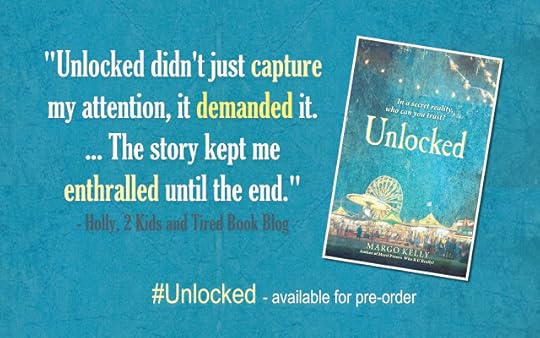
 http://www.insecurewriterssupportgroup.com/One of the things I find most helpful is when other writers share useful information about the craft and career of writing. Here are some sites with great writing topics, which I recently found informative and inspiring:
http://www.insecurewriterssupportgroup.com/One of the things I find most helpful is when other writers share useful information about the craft and career of writing. Here are some sites with great writing topics, which I recently found informative and inspiring:123 Ideas for Character Flaws
7 Things Professional Writers Know
How to Write a Thriller
AND ... before you go ... let me tell you about two giveaways currently happening for my next novel, UNLOCKED.
First: My publisher, Merit Press, is giving away 25 hardback copies of UNLOCKED over at Goodreads. Hop on over there and enter to win!
Second: As a thank you for your continued support, I'm offering a separate giveaway, for YOU, here! I am giving away a signed Advance Reader Copy of UNLOCKED. (Contest open internationally.) You can earn an entry into the random drawing for each of the items below - for each day of the contest. Simply email me at: margokelly1 @ outlook . com (without the spaces) and let me know which items you've completed. Hurry, this IWSG giveaway will close 8/7/16. Winner will be announced here and by email.
1. Share the link to the Goodreads giveaway on Twitter and tag @MargoWKelly and @Merit_Press https://www.goodreads.com/giveaway/sh...
2. Join the social media "Book Blitz" hosted by YA Bound Book Tours - CLICK HERE
3. Share this picture (if you'd prefer I email you a .jpg - just let me know) on any social media and tag me if possible:

Published on August 03, 2016 01:30
July 27, 2016
Book Review: SOUL OVER MATTER by Zhi Gang Sha and Adam Markel
 Soul Over Matter: Ancient and Modern Wisdom and Practical Techniques to Create Unlimited Abundance by Zhi Gang Sha
Soul Over Matter: Ancient and Modern Wisdom and Practical Techniques to Create Unlimited Abundance by Zhi Gang ShaMy rating: 4 of 5 stars
Scroll down for my full review, but first, here is more information from the publisher:
Soul Over Matter: Ancient and Modern Wisdom and Practical Techniques to Create Unlimited Abundance
By Dr. & Master Zhi Gang Sha and Adam Markel
Published by BenBella Books
Hardcover: 168 pages
July 12, 2016; $24.95 US/$32.50 CAN
9781942952589
Description:
Combine ancient Eastern and modern Western wisdom, mix in proven techniques from both a CEO and a legendary soul healer, and you get Soul Over Matter. Designed for readers at every level of economic experience, this book gives you a unique and powerful path to financial abundance.
Adam Markel, bestselling author, attorney and CEO of New Peaks, North America’s largest personal and business development company, shares inspiring life lessons and strategies to create abundance. World-renowned miracle soul healer, Dr. & Master Zhi Gang Sha reveals sacred and practical wisdom, including universal laws that everyone can apply to create abundance in every aspect of life: personal finances, business, relationships and more.
Destined to be the Think and Grow Rich of the 21st century, Soul Over Matter shares practical wisdom and easy-to-implement, proven techniques. In addition, Master Sha, who is a Tao master teacher of one-stroke calligraphy for transformational healing, provides two new calligraphies that carry extraordinary power to remove blockages to achieving lasting abundance. With these simple techniques, you’ll learn how to focus on your unique challenges and conquer them.
Soul Over Matter is the first financial advice book to focus on the role of soul in creating abundance. Whereas other books have hinted at the importance of connecting to universal laws to create abundance, Soul Over Matter is the first book to deliver the techniques to do so.
Discover how Soul Over Matter can change your relationship with money.
Authors:
Dr. & Master Zhi Gang Sha is a world-renowned master healer and spiritual teacher. He is the founder of Soul Mind Body Medicine™. Trained as a conventional medical doctor in China and a doctor of traditional Chinese medicine in China and Canada, Master Sha is the founder of the Institute of Soul Healing and Enlightenment™ and the Love Peace Harmony Foundation™, and a grandmaster of many ancient disciplines, including tai chi, qigong, kung fu, feng shui, and the I Ching.
Adam Markel is a bestselling author and CEO of New Peaks, one of the world’s largest integrative personal and business development companies. He is also an attorney and the author of the bestselling book Pivot: The Art & Science of Reinventing Your Career and Life. Adam has presented to more than 100,000 people around the world on how to live more balanced, healthy, and prosperous lives. Additionally, he’s been featured in Fox News, Entrepreneur, USA Today, The New York Observer, The New York Post, and The Wall Street Journal.
MY REVIEW:
I was so excited to receive this book. I love non-fiction books that mesh eastern and western philosophies, and I was especially interested in this book because my husband and I are currently reevaluating our financial situation and looking for ways to improve it.
Imagine my disappointment when I read this line: “The root cause for financial lack is one’s negative personal karma and negative ancestral karma from all lifetimes” (page 36).
Wait. What?
“If you lack physical money, you do not have much good virtue [good karma] deposited in your Heaven’s virtue bank account” (page 45). Hmm. I couldn’t agree that Heaven intentionally withheld money from me. Unless, we had different definitions of Heaven. As I read, I felt myself getting defensive, and that famous Shakespeare quote popped into my head: “The lady doth protest too much.” And I had to pause. Maybe I was getting defensive, because I didn’t want to give validity to what I was reading. I didn’t want to think Heaven withheld monetary blessings from me.
Furthermore, I thought I knew what karma was and had strived to create positive karma in my life. But this book stated over, and over, and over again that “According to ancient wisdom, positive virtue [good karma] determines how much financial flourishing … a person enjoys” (page 110). This troubled me. I immediately started comparing myself to others who have a ton of money and asking myself, do they seriously have better karma than I do? But then I read more in the book, and imagine my surprise when I read that bad karma is created by “criticizing, condemning, judging, complaining … jealousy” (page 42). Oh. My. I was screwed.
So I continued reading, hoping to learn techniques to clear my bad karma. I’ve always been a fan of positive thinking, and I was excited to learn ways to improve myself. But rather than simply explaining the techniques, the middle of this book became repetitive and detail oriented. Instead of giving the reader the information only in English, the author gave the Chinese words and then translated them word by word and then finally strung the words into a sentence in English. I found myself skimming ahead, skipping the microscopic translations, to get to the full sentence in English. Maybe the chants were supposed to be done in Chinese because those specific vocal sounds created a specific vibration, but then that also made me stop to wonder, why couldn’t it work in English? If these were universal truths, shouldn’t the concept surpass language? I struggled with the ideas of chanting Chinese phrases and tracing specific pieces of calligraphy to improve my financial situation. Maybe I’m not enlightened enough to grasp the concept. (Probably, and I certainly mean no disrespect to the authors and their personal beliefs.)
While there were things that I disagreed with in the text, I loved finding the simple truths in this book that broke through all barriers. When something is true, it’s true everywhere.
Here are a few of the beautiful, simple truths I found in this book:
“One of the primary principles of both mind over matter and soul over matter is that you must have a “why” in what you do that benefits others. The more you serve others, the more you are likely to receive” (page 6).
“If our thoughts of scarcity and, as a result, our words of scarcity are habitual, then scarcity itself is also habitual” (page 10).
“The greatest danger when things go wrong isn’t the thing going wrong, but your judgment of yourself in the situation. … But the cause, the response, the behavior, the resolution—they all matter less than how you treat yourself in their wake … you take failure personally … that perception is also what slows you down. It stops you from trying something new. From taking risks. From doing things that are intuitive. That failure phobia stops you from taking a moment to listen to that inner voice, the whisper of your soul, saying Try something different” (page 18-19).
“Ultimately, the purpose of the physical journey is to serve the soul journey. This is the greatest wisdom that many spiritual seekers are searching for” (page 122).
“When you narrow your focus to only the obstacles and not the opportunities, there’s nowhere else to go but where you’re already headed … you have to be willing to look away from the obstacle. You need to have the presence of mind—the mindfulness—to direct your energy away from the negative, toward where or what it is that you want” (page 132).
Overall, I highly recommend this book. Regardless of whether you believe in karma and reincarnation, or not, if you are open-minded, you will appreciate the universal truths found in this book. It was very well written, eye opening, and thought provoking.
[My thanks to FSB Associates for sending me a free copy for review. This did not influence my opinion at all.]
View all my reviews
Published on July 27, 2016 15:25
July 20, 2016
July 20 = National Lollipop Day
With all the turmoil in the world, let's take a minute to enjoy something sweet.

That's right! July 20th is recognized as National Lollipop Day (a colorful, enjoyable, and unofficial U.S. holiday of sorts).
Here are a few interesting tidbits (according to my brief research) about the sweet treat:
In 2012 See's Candies made the world's largest lollipop weighing in at 7000 pounds.
The original lollipop machine manufactured 40 lollipops per minute while modern machines make nearly 6000 per minute.
The true origin of the candy on a stick is debatable, but many give credit to George Smith, who trademarked the name lollipop in 1931. It's believed he named the candy after a horse he admired.
There are some "adult only" lollipops that contain various ingredients such as alcohol, dietary aids, and INSECTS. Blech.
In 1939 the Wizard of Oz movie introduced us to the Lollipop Guild.
In 1969 Tootsie Roll gave us the commercial asking, "How many licks does it take to get to the center of a Tootsie Pop?"
But of course the best thing about National Lollipop Day is this video with Shirley Temple singing, "On the Good Ship Lollipop":

That's right! July 20th is recognized as National Lollipop Day (a colorful, enjoyable, and unofficial U.S. holiday of sorts).
Here are a few interesting tidbits (according to my brief research) about the sweet treat:
In 2012 See's Candies made the world's largest lollipop weighing in at 7000 pounds.
The original lollipop machine manufactured 40 lollipops per minute while modern machines make nearly 6000 per minute.
The true origin of the candy on a stick is debatable, but many give credit to George Smith, who trademarked the name lollipop in 1931. It's believed he named the candy after a horse he admired.
There are some "adult only" lollipops that contain various ingredients such as alcohol, dietary aids, and INSECTS. Blech.
In 1939 the Wizard of Oz movie introduced us to the Lollipop Guild.
In 1969 Tootsie Roll gave us the commercial asking, "How many licks does it take to get to the center of a Tootsie Pop?"
But of course the best thing about National Lollipop Day is this video with Shirley Temple singing, "On the Good Ship Lollipop":
Published on July 20, 2016 08:02



